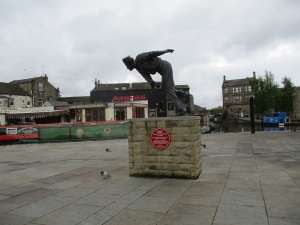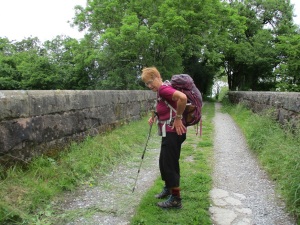Our plan for the day was to walk along the Basingstoke Canal from Odiham to Greywell Tunnel, find a couple more caches in the village of Greywell before returning to Odiham via North Warnborough. We hoped to arrive back in Odiham before the forecasted heavy rain arrived.
The Basingstoke Canal ran from Basingstoke to Weybridge (where it connected to the River Thames). Like many other canals it fell derelict in the 1950s. Much restoration has taken place, but sadly the full route cannot be reopened as the Greywell Tunnel has collapsed.
We walked this section of the canal in 2011, as it formed part of the ‘Three Castles Path‘; a route linking Windsor Castle, Odiham Castle and Winchester. It apparently forms the route that King John took prior to signing the Magna Carta.
We should have parked in the car park next to the canal, but our memory suggested it was only for users of the John Pinkerton, a canal boat trip company. We parked in the road, and just we were about to join the towpath we were asked whether we were with a ramblers group. Apparently a group from Staines-Upon-Thames were meeting at the car park at the same time we were starting our walk.
We joined the towpath and looked for the first cache. In fairness we knew we weren’t going to find it, as it needed some sort of boat/canoe/inflatable to reach the far bank. As we couldn’t even see the cache from our side of the canal, we didn’t try to commandeer a boat from a passer-by. There was much going on, the John Pinkerton was about to leave with a 50th birthday party on board, a couple of ‘travellers’ were lighting fires, and were having fun with their horse-and-carts.
We strode away, anxious to keep ahead of the other rambling group. They had caught us by our first genuine cache attempt of the day. Several trees and ivy to search and sadly a did-not-find for us. A bad start.


Our next cache was an adventure lab cache. We had 5 waypoints along the canal and a question to answer at each. The first was a little distance away at a swingbridge, the second at Odiham Castle. The castle is a ‘ruin’ anyway, but clearly there have been some incidents recently with the brickwork as scaffolding surrounded the castle. We had to do some counting in the castle, and it wasn’t easy. Inside were fences protecting the castle walls from people’s hands. We had to count the green upright fence poles all the way round. These poles were 4-6 inches apart and it took us some time…and then we disagreed on an answer. Mrs Hg137 counted again, while Mr Hg1307 set about the investigation work for an earthcache based on the geology found in and around the castle walls. Mrs Hg137 put her number into the adventure lab… another failure. Mr Hg137 counted and he managed to get the correct answer. To give you some idea the final number is in the 250-350 range!



After getting the answer correct, and completed the earthcache questions, we paused for coffee. About this time the John Pinkerton arrived, and some of the attendees of the 50th birthday left the boat to admire the castle.
Just beyond the castle is the ‘head of navigation’ and the boat turned round while some of the partygoers stayed onboard, as the other half went round the castle.


We resumed our walk, and almost immediately had another adventure lab question to answer, this time to do with the River Whitewater which went UNDER the canal. It is very unusual for this happen, and we were not aware of this feature when we walked the Three Castles Path previously.
The path on a Saturday was quite busy, cyclists, dog walkers all out and about before the forecasted afternoon rain arrived. About a mile after the Whitewater we arrived at Greywell Tunnel, which is now a renowned bat roost with several species of bat roosting there. This was our final question for the ad lab, and we successfully answered it. This gave us the coordinates for a final, bonus cache…some distance back along the canal, probably near the castle. Sadly for us.. not part of our planned route.
We were in the village of Greywell, and we had a couple of caches to find. The first, hidden in the roots of a tree. Sadly for us, and like many cachers before us, we took the wrong footpath to the cache and ended up the wrong side of barbed wire fence.



After some retracing, we found the cache quite easily.
Unlike our next cache.
Part of the ‘bat’ series around the Odiham area. Hidden unusually in the porch area of a church.
Gardeners were leaving the churchyard as we approached and the porch area was full of flower-filled jam jars – presumably removed from various graves. We weren’t interested in the flowers, but a small ‘bat’. We couldn’t find the bat – we searched high (trying not to knock over the jam jars) and low, all to no avail. We decided to give up and collect numbers for the Church micro multi cache. We visited a grave, collected numbers and ascertained the final was some distance away. We ate lunch back at the porch. There really were few places to hide a cache. We decided to give ourselves 5 more minutes as we supped a coffee. Mrs Hg137 finished hers, and just as Mr Hg137 was finishing his…he spotted the cache. Suffice to say the jam jars were the problem and had prevented a full scale search of a particular area.
We signed the log, and then went to collect the Church Micro multi-cache. As were signing the log… the heavens opened and the afternoon rain (which we were expecting about 3pm, arrived at 130! )
Ugh! We still had some way to go and several caches to find!
We decided to return to the canal (via another cache – this time by the beautiful river Whitewater) and walk back the way we came. Not exciting, but we could hurry if the rain got harder and not think about navigation. It also gave us a change to collect the adventure lab bonus cache. Even this was tricky, as a group of people loitered next to its location for far too long, which prevented us from searching.
We returned the car, damp and slightly disillusioned that we had to abandon our route.. but on the bright side we can always come back another day!

























































































































































